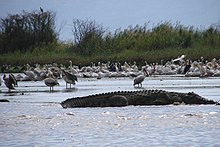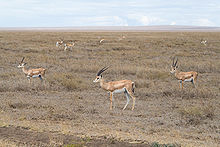Nechisar National Park: Difference between revisions
Copyvio revdel completed (RR) |
The Swaynes's hartebeest is extinct in the park since around 2017. I updated this fact and put a citation. This fact was also confirmed through the park managment in October 2023 during an interview that I held during a work related field mission. |
||
| Line 46: | Line 46: | ||
== Wildlife == |
== Wildlife == |
||
[[File:Grant's Gazelle.jpg|thumb|The park has a notable population of [[Grant's gazelle]]]] |
[[File:Grant's Gazelle.jpg|thumb|The park has a notable population of [[Grant's gazelle]]]] |
||
Wildlife in the park include [[plains zebra]], [[Grant's gazelle]], [[dik-dik]], [[hippopotamus]], [[African leopard]], [[spotted hyena]], and [[greater kudu |
Wildlife in the park include [[plains zebra]], [[Grant's gazelle]], [[dik-dik]], [[hippopotamus]], [[African leopard]], [[spotted hyena]], and [[greater kudu]], [[lion]], and [[cheetah]].<ref name=AfricanParks>{{cite web|url=http://www.african-parks.org/apffoundation/index.php?option=com_content&task=view&id=60&Itemid=98|publisher=www.african-parks.org|title=Nech Sar - Description|accessdate=2008-04-09|url-status=dead|archiveurl=https://web.archive.org/web/20110724225427/http://www.african-parks.org/apffoundation/index.php?option=com_content&task=view&id=60&Itemid=98|archivedate=2011-07-24}}</ref> A stretch of the northwest shore of Lake Chamo is known as Crocodile Market, where hundreds of [[Nile crocodile]]s gather to bask. The park also hosts [[bushbuck]], [[waterbuck]], [[bushpig]], [[Anubis baboon]], [[vervet monkey]]s, and [[black-backed jackal]]. Nechisar hosted as well one of the last three populations of the endangered [[Swayne's hartebeest]]. Unfortunately the population is now most certainly extinct, the last specimen has been sighted in 2017.<ref>{{Cite journal |last=Fetene |first=Aaramde |last2=Yeshitela |first2=Kumelachew |last3=Gebremariam |first3=Ephrem |date=2019-12 |title=The effects of anthropogenic landscape change on the abundance and habitat use of terrestrial large mammals of Nech Sar National Park |url=https://environmentalsystemsresearch.springeropen.com/articles/10.1186/s40068-019-0147-z |journal=Environmental Systems Research |language=en |volume=8 |issue=1 |doi=10.1186/s40068-019-0147-z |issn=2193-2697}}</ref> |
||
The endangered [[African wild dog]] ''Lycaon pictus'', once existed in the park, but may now be [[Local extinction|extirpated]] due to [[Human overpopulation|human population pressures]] in this region.<ref>Hogan, C. M. (2009). [http://globaltwitcher.auderis.se/artspec_information.asp?thingid=35993 ''Painted Hunting Dog: Lycaon pictus''] {{webarchive|url=https://web.archive.org/web/20101209234758/http://globaltwitcher.auderis.se/artspec_information.asp?thingid=35993 |date=2010-12-09 }}, GlobalTwitcher.com, ed. N. Stromberg</ref> |
|||
In 2009, a small group of less than 23 lions were estimated in and around the protected area.<ref>{{cite journal |author1=Yirga, G.|author2=Gebresenbet, F.|author3=Deckers, J. |author4=Bauer, H. |year=2014 |title=Status of Lion (''Panthera leo'') and Spotted Hyena (''Crocuta crocuta'') in Nechisar National Park, Ethiopia |journal=Momona Ethiopian Journal of Science |volume=6 |issue=2 |pages=127−137 |doi=10.4314/mejs.v6i2.109714 |doi-access=free}}</ref> |
In 2009, a small group of less than 23 lions were estimated in and around the protected area.<ref>{{cite journal |author1=Yirga, G.|author2=Gebresenbet, F.|author3=Deckers, J. |author4=Bauer, H. |year=2014 |title=Status of Lion (''Panthera leo'') and Spotted Hyena (''Crocuta crocuta'') in Nechisar National Park, Ethiopia |journal=Momona Ethiopian Journal of Science |volume=6 |issue=2 |pages=127−137 |doi=10.4314/mejs.v6i2.109714 |doi-access=free}}</ref> |
||
Revision as of 10:31, 18 January 2024
| Nechisar National Park | |
|---|---|
 Nechisar National Park with Lake Abaya on the left and Lake Chamo on the right | |
| Location | Southern Nations, Nationalities, and Peoples' Region, Ethiopia |
| Nearest city | Arba Minch |
| Coordinates | 6°2′N 37°35′E / 6.033°N 37.583°E |
| Area | 1,030 km2 (400 sq mi) |
| Established | 1974 |
| Website | nechisarnationalpark |
 | |
Nechisar National Park (or Nech-Sar National Park) is a national park in the Southern Nations, Nationalities, and Peoples' Region of Ethiopia.[1] It is in the Great Rift Valley within the southwestern Ethiopian Highlands.
Geography
The 750-square-kilometre (190,000-acre) park includes the "Bridge of God", an isthmus between Lake Abaya and Lake Chamo, and the Nechisar (English: white grass) plains east of the lakes. It is east of Arba Minch.
Park elevations range between 1,108 and 1,650 metres (3,635 and 5,413 ft) above sea level.[2] Nechisar National Park was established in 1974. Under the management of African Parks Network (APN since 2005, it was reportedly scheduled to hand over management to the Ethiopian government in June 2008.[3]
History and management

As part of a 1960s UNESCO plan to protect and conserve nature and natural resources in Ethiopia, a two person team of UNESCO consultants spent three months surveying most major wildlife areas in Ethiopia, and officially submitted to the Wildlife Conservation Board in 1965 their recommendations, which included a game reserve to the east of Lake Chamo to provide protection for the population of Swayne's hartebeest and other local wildlife.
Nechsar National Park was proposed in 1967, then officially established in 1974. Since then it has not legally been gazetted, but has functioned as de facto national park.[4] Following the recommendations of the Ethiopian Ministry of Agriculture recommendation, in 1982 the local Guji, who had been living as pastoralists in the lowlands beside Lake Abaya and Chamo "were forcibly evicted from the park at gun point".[5]
In the lawless period at the end of the Derg rule and immediately afterwards, Nechisar suffered much damage. Park buildings located far from the headquarters were looted and damaged. At the same time, the local Guji returned to their traditional grazing areas. According to one source, they fled there from the attacks of the Borena Oromo, who in turn were victimized by neighboring ethnic groups, their presence degrading the environment and contributing to the local extinction of many species. The Guji also acquired firearms during this period, and used them to resist eviction from the park afterwards.[6] In 2005, Refugees International criticized their eviction.[7]
In 2005, the management responsibility for Nechisar National Park was handed over to African Parks.[8]
While tourism in Ethiopia has increased in the park in recent years, doubling each year from 5300 tourists in 2005 to 20,500 in 2007, in October 2008 African Parks announced that they were ending management of Nechisar National Park. In a magazine article reprinted on their website, African Parks claims that sustainable management of the Ethiopian parks is incompatible with "the irresponsible way of living of some of the ethnic groups". African Parks added that the emphasis for resettling inhabitants out of the park, rather than educating them to work with them, came from the Ethiopian government. African Parks was told that the Guji were an Oromo people, and "they belong in the adjoining Oromiya province, not among the Gamo and Gofa peoples of the Southern District, where the park is".[9]
Geography and landscape

The important regional centre to the park is Arba Minch in the Main Ethiopian Rift. Approximately 15% of the park consists of lakes including Lake Abaya in the north and Lake Chamo in the south. Part of the habitat consists of the groundwater forest and shoreline of the lakes, but there are also dry grassy plains. The altitude ranges from 1,108 meters above sea level at the shore of Lake Chamo to 1,650 meters on Mount Tabala in the north-east, renowned for its hot springs.[10] Taller trees found in the park include Dichrostachys cinerea, Acacia tortilis, Balanites aegyptiaca and less common Acacia nilotica. The southern part of the park is dominated by edaphic grassland and a calcareous black clay soil underneath with Dobera glabra, Acacia tortilis and the grass Chrysopogon aucheri forming much of the landscape.[10] Both invasive species and woody plant encroachment are a threat to the biodiversity of the national park.[11]
Wildlife

Wildlife in the park include plains zebra, Grant's gazelle, dik-dik, hippopotamus, African leopard, spotted hyena, and greater kudu, lion, and cheetah.[8] A stretch of the northwest shore of Lake Chamo is known as Crocodile Market, where hundreds of Nile crocodiles gather to bask. The park also hosts bushbuck, waterbuck, bushpig, Anubis baboon, vervet monkeys, and black-backed jackal. Nechisar hosted as well one of the last three populations of the endangered Swayne's hartebeest. Unfortunately the population is now most certainly extinct, the last specimen has been sighted in 2017.[12]
The endangered African wild dog Lycaon pictus, once existed in the park, but may now be extirpated due to human population pressures in this region.[13] In 2009, a small group of less than 23 lions were estimated in and around the protected area.[14]
Nechisar National Park is considered an important habitat for birds including kingfishers, storks, pelicans, flamingos and African fish eagles.[15]
References
- ^ "Nech-sar". Protected Planet. Retrieved 2021-06-11.
- ^ Camerapix (2000) Spectrum Guide to Ethiopia. Barbara Lawrence Balletto (Editor). New York: Interlink. ISBN 156656350X. p. 318.
- ^ Africa Parks to Leave Nech Sar[permanent dead link], March 15, 2008, The Ethiopian Reporter, Retrieved on June 22, 2008
- ^ Abiyot Negera Biressu (2009) "Resettlement and local livelihoods in Nechsar National Park, Southern Ethiopia", Master's thesis in indigenous studies, University of Tromsø, pp. 22-24.
- ^ As detailed in Abiyot Negera Biressu, pp. 27ff
- ^ Michael J. Jacobs and Catherine A. Schloeder "Impacts of Conflict on Biodiversity and Protected Areas in Ethiopia: Summary of Impacts". worldwildlife.org
- ^ [1], Thompson, Larry (19 Apr 2005), "Ethiopia: Local People Burned Out of Homes to Make Way for National Park". Refugees International.
- ^ a b "Nech Sar - Description". www.african-parks.org. Archived from the original on 2011-07-24. Retrieved 2008-04-09.
- ^ "Why African Parks Network is pulling out of Ethiopia"
- ^ a b Nechisar National Park Archived 2013-10-28 at the Wayback Machine, Realethiopia.com, January 4, 2006, Retrieved on June 22, 2008
- ^ Alemu, M. M. (2022). "Status and Prospects of Biodiversity in Nech Sar National Park". Human Activity, Biodiversity and Ecosystem Services in Protected Areas. Cham: Springer International Publishing. pp. 51–93. doi:10.1007/978-3-030-89571-6_3. ISBN 978-3-030-89570-9. S2CID 245189444.
- ^ Fetene, Aaramde; Yeshitela, Kumelachew; Gebremariam, Ephrem (2019-12). "The effects of anthropogenic landscape change on the abundance and habitat use of terrestrial large mammals of Nech Sar National Park". Environmental Systems Research. 8 (1). doi:10.1186/s40068-019-0147-z. ISSN 2193-2697.
{{cite journal}}: Check date values in:|date=(help)CS1 maint: unflagged free DOI (link) - ^ Hogan, C. M. (2009). Painted Hunting Dog: Lycaon pictus Archived 2010-12-09 at the Wayback Machine, GlobalTwitcher.com, ed. N. Stromberg
- ^ Yirga, G.; Gebresenbet, F.; Deckers, J.; Bauer, H. (2014). "Status of Lion (Panthera leo) and Spotted Hyena (Crocuta crocuta) in Nechisar National Park, Ethiopia". Momona Ethiopian Journal of Science. 6 (2): 127−137. doi:10.4314/mejs.v6i2.109714.
- ^ WordTravels Ethiopia Travel Guide Archived 2017-12-01 at the Wayback Machine, Retrieved on June 22, 2008

